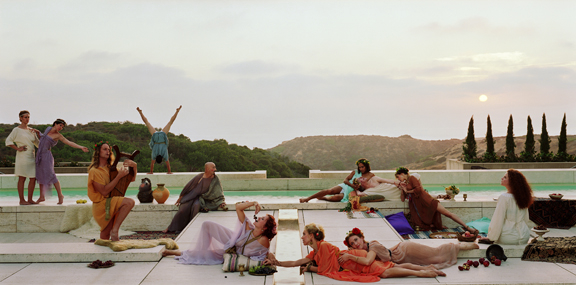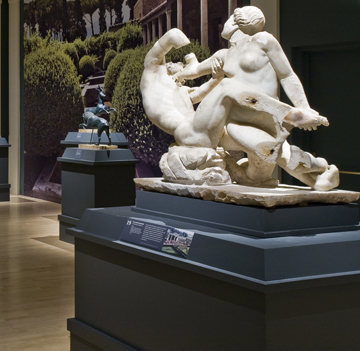
Eleanor Antin, "The Death of Petronius" from "The Last Days of Pompeii," 2001. Chromogenic print, 46 5/8 x 94 5/8 inches. Courtesy Ronald Feldman Fine Arts, New York.
The Los Angeles art world still has a lot of the laissez-faire approachability that endeared it back in the ’60s, which is why so many artists migrate to L.A. and never leave. Lily Simonson and Catherine Wagley, who both came to the West Coast as art students, have made the city home. Looking at Los Angeles is their new bi-weekly dispatch about art in the city they love. — Ed.
For our first dispatch from the LA art world, we visited the exhibition Pompeii and the Roman Villa: Art and Culture around the Bay of Naples, on view at LACMA until October 4. The show features sculptures, paintings, and tapestries that adorned the private villas of the Roman elite, and is accompanied by Eleanor Antin‘s The Last Days of Pompeii (Season 2), a project that brings ancient decadence to SoCal. Thoughts about aged culture, contemporary art and the City of Angels prompted the following conversation:
Catherine Wagley: Here in LA, even authentic antiquity feels like faux antiquity. That’s why I avoid shows like Pompeii. I feel so limited as a viewer–I have no concept of Pompeii as a place that occupied a past era; instead, when I look at the artifacts on exhibit, I start thinking about decorations on the Getty’s fountains. But I actually enjoyed the LACMA show because it addresses this very conundrum.
Lily Simonson: Yes, there is virtually no history embodied anywhere in Los Angeles, and that is very unsettling. My neighborhood in Hollywood is overrun by European tourists taking pictures of the Walk of Fame and trying to get to the Hollywood Sign. Is that our Eiffel Tower? Yikes! Our history is all about cultural production and artifice, so everything begins to seem inauthentic or reproducible.
Anyway, I agree that LACMA gracefully embraced the incongruity of a show like this in Los Angeles, especially by juxtaposing the exhibition with Antin’s Pompeii series. In fact, the Antin piece at once underscored this cultural “mismatch” while highlighting the parallels between the opulent Hollywood Empire and the dangerously extravagant Romans. I’ve been thinking about the inclusion of the Art21-like video that documented Antin’s process making the Pompeii photographs. It made the work feel like a Hollywood production.
CW: Do you mean the video made Antin’s work seem like a Hollywood production? Or that it made those grand ancient sculptures look like they jumped off a Hollywood set? I was entranced by the latter possibility. What’s great about Antin’s Pompeii photos is that her production value is so high, yet the scenes are flawed. Actors seem bored, bodies have blemishes, the theatricality is transparent. And it’s the same with the sculptures on exhibit. They’re crafted with such gravitas and yet time has damaged them in a way that makes their theatricality seem naked.

"Satyr and Hermaphrodite." Oplontis, so-called Villa of Poppaea. Installation at LACMA. Courtesy of Museum Associates/LACMA
One of my favorite pieces in Pompeii, Satyr and Hermaphrodite, shows two androgynous figures engaged in a struggle. The Hermaphrodite’s hand is forced into the Satyr’s face, the Satyr is reaching for the Hermaphrodite, and you can’t quite tell if they’re trying to pull one another closer or ward one another off. To top it off, the limbs of these figures have broken off in key places–the Satyr’s missing part of his forearm and I think the Hermaphrodite is missing a knee cap–making the activity they’re engaged more absurd. Looking at this sculpture now, I have trouble imagining it was ever anything but theatrical.
LS: Wow, this feels like the elephant in the room! There is always a lot of hubbub about preserving ancient art, to the extent that the conservation process can overshadow the work itself. The art from Pompeii is particularly enthralling because Vesuvius’ lava paradoxically destroyed the culture while preserving much of the art. But nobody really talks about the effects these imperfections have on the impact of the work itself. As viewers, we are implicitly charged to admire the feats of conservators (human or volcanic), while ignoring the bits and pieces that cannot be restored. Yet if we accept that form generates meaning, then these kinds of changes in the form are going to alter the experience of the viewer.
It’s interesting that you brought up Satyr and Hermaphrodite as an example of this twist in the visual experience–it’s certainly replete with ambiguities. You come upon the sculpture and it feels like a good old scene of female victimization. Then as you circle it, you see that those sumptuous breasts are accompanied by male genitalia. When this show was exhibited at the National Gallery last year, there was a potted plant obscuring the view of the Hermaphrodite’s genitalia. That seems like such a travesty! One thing I can say for LA is that we’re not afraid of sexuality, no matter how weird it gets.
CW: Maybe we just identify with weirdness, or want to. I like what you said about Vesuvius destroying a culture and preserving art. Here’s how I loosely relate that to LA: Irving Blum, the co-owner of the famed Ferus gallery, found in LA general hostility to anything new. He said, “In the one place where that hostility had no right to exist, one encountered [it].” Angelinos wanted their art to preserve past cultures, cultures to which they had no real relationship. Of course, things have changed since Blum’s reign in the 1960s. Now, contemporary art, in LA and elsewhere, is pretty much accepted as the making or remaking of culture (not that it always does this well).
LS: Perhaps Angelinos were more like the Romans, who wanted their art to be like the Greeks. But then Los Angeles got tired of its reputation for being barren of culture and made a concerted effort to create culture. The success of those attempts is of course dubious. Can you fabricate culture? I guess we should ask Eli Broad. Now that the money is disappearing, is our bit of culture going to vanish like Pompeii? Is the recession our Vesuvius? On the other hand, this could be the most fertile time of all… and we’ll be here watching!




Pingback: What’s Cookin on the Art21 Blog: A Weekly Index | Art21 Blog
Pingback: Blog From NY